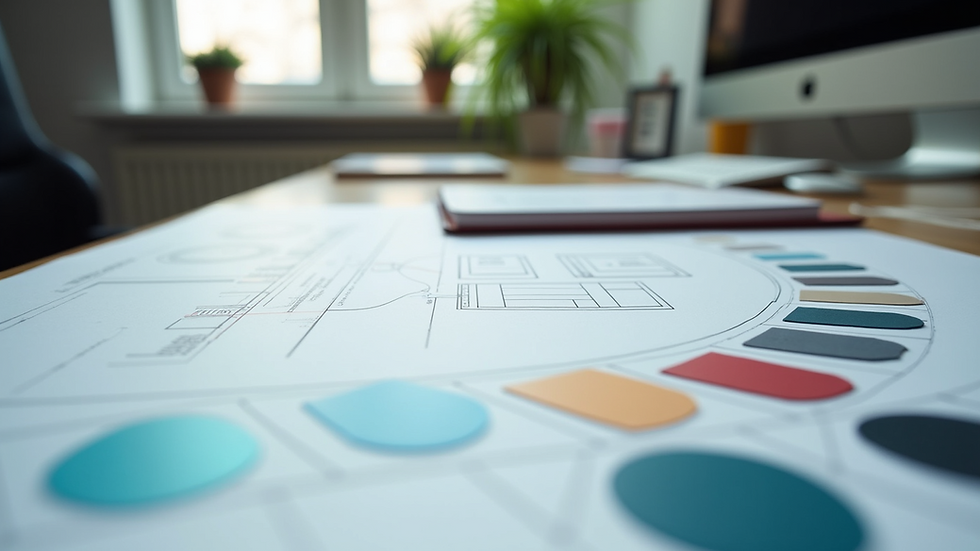Crafting Exceptional Professional Websites
- M J
- Sep 22, 2025
- 4 min read
Creating a website that stands out in today’s digital world requires more than just attractive visuals. It demands a strategic approach that combines aesthetics, functionality, and user experience. Modern website design is about crafting a platform that not only looks great but also serves its purpose effectively. Whether you are building a site for a business, portfolio, or blog, understanding the key elements of modern website design will help you create an exceptional online presence.
Understanding the Essentials of Modern Website Design
Modern website design focuses on simplicity, responsiveness, and user engagement. It is essential to keep the design clean and intuitive so visitors can navigate easily. Here are some core principles to consider:
Responsive Layouts: Your website must look great on all devices, from desktops to smartphones. Responsive design ensures that content adjusts smoothly to different screen sizes.
Fast Loading Times: Users expect websites to load quickly. Optimizing images, minimizing code, and using reliable hosting can improve speed.
Clear Navigation: Menus and links should be easy to find and use. A well-structured navigation system helps visitors find information without frustration.
Consistent Branding: Use colors, fonts, and imagery that reflect your brand identity. Consistency builds trust and recognition.
Engaging Content: Content should be relevant, concise, and valuable to your audience. Use headings, bullet points, and visuals to make it easy to read.
By focusing on these essentials, you can create a website that not only attracts visitors but also keeps them engaged.

Key Features of Modern Website Design
To make your website truly modern and effective, consider incorporating these features:
1. Minimalist Design
Minimalism is a hallmark of modern design. It emphasizes whitespace, simple color schemes, and limited use of decorative elements. This approach reduces distractions and highlights the most important content.
2. Mobile-First Approach
Designing for mobile devices first ensures that your site performs well on smaller screens. This approach often leads to cleaner, more focused designs that translate well to larger screens.
3. Interactive Elements
Adding interactive features like sliders, hover effects, and animations can enhance user engagement. However, use these sparingly to avoid overwhelming visitors.
4. High-Quality Visuals
Use professional photos, icons, and graphics to create a polished look. Avoid stock images that feel generic or overused.
5. Accessibility
Ensure your website is accessible to all users, including those with disabilities. Use proper contrast, alt text for images, and keyboard-friendly navigation.
6. SEO Optimization
A modern website should be optimized for search engines. Use relevant keywords, meta tags, and clean URLs to improve your site’s visibility.
By integrating these features, your website will meet the expectations of today’s users and perform well in search rankings.

What are the 5 golden rules of web design?
Understanding the fundamental rules of web design can guide you in creating a site that is both functional and visually appealing. Here are the five golden rules:
1. Keep It Simple
Avoid clutter and unnecessary elements. A simple design helps users focus on your content and makes navigation easier.
2. Make Navigation Intuitive
Users should be able to find what they need quickly. Use clear labels, logical menu structures, and consistent placement of navigation elements.
3. Use Consistent Design Elements
Consistency in fonts, colors, and layout creates a cohesive experience. It also reinforces your brand identity.
4. Prioritize Content
Content is the heart of your website. Make sure it is well-organized, easy to read, and relevant to your audience.
5. Optimize for Speed and Performance
Slow websites frustrate users and increase bounce rates. Optimize images, use efficient coding practices, and choose reliable hosting.
Following these rules will help you build a website that is user-friendly, attractive, and effective.
The Role of Professional Web Design in Your Website’s Success
While DIY website builders are popular, investing in professional web design can make a significant difference. Professionals bring expertise in design principles, coding, and user experience that can elevate your site beyond basic templates.
Benefits of Hiring Professionals
Custom Solutions: Tailored designs that fit your unique needs and goals.
Technical Expertise: Advanced coding and optimization for better performance.
SEO Knowledge: Strategies to improve your site’s search engine ranking.
Ongoing Support: Maintenance and updates to keep your site current and secure.
A professionally designed website can enhance your brand’s credibility and provide a seamless experience for your visitors.

Practical Tips for Crafting Your Website
Here are actionable recommendations to help you create an exceptional website:
Plan Your Structure: Outline your site’s pages and content hierarchy before designing.
Choose the Right Platform: Select a content management system (CMS) that suits your technical skills and needs.
Focus on User Experience (UX): Test your site with real users to identify pain points.
Use Analytics: Monitor visitor behavior to make data-driven improvements.
Keep Content Updated: Regularly refresh your content to stay relevant and improve SEO.
Incorporate Calls to Action (CTAs): Guide visitors towards desired actions like signing up or making a purchase.
Ensure Security: Use SSL certificates and keep software updated to protect your site and users.
By following these tips, you can build a website that not only looks great but also achieves your goals effectively.
Moving Forward with Your Website Design Journey
Crafting an exceptional modern website design is a continuous process. Trends evolve, technologies advance, and user expectations change. Staying informed and adaptable will help you maintain a website that remains effective and engaging.
Remember, the foundation of a successful website lies in combining aesthetics with functionality. Whether you choose to design it yourself or collaborate with experts, focusing on user experience, performance, and clear communication will set your site apart.
Start today by evaluating your current website or planning your new one with these principles in mind. Your online presence is a powerful tool - make it exceptional.






